Unlike other projects that solely pursue short-term bursts, Sonic has chosen a path of "slow and steady wins the race."
Author: Deep Tide TechFlow
In a moment of market silence, the once vibrant scene of "hundreds of chains contending" has gradually quieted down. Users are no longer simply swayed by narratives but are deeply contemplating the intrinsic value of projects.
On a larger scale, market attention is becoming increasingly fragmented. Users no longer blindly chase trends, making it difficult for any single ecosystem to create a FOMO effect among the majority. Everyone is choosing to play their own game, with no one picking up anyone else's play; however, on a micro level, once users recognize the value of a particular ecosystem, they will deeply engage, seeking certain opportunities through building and exploration.
When it comes to ecosystems that users truly believe in and immerse themselves in, the currently highly popular Sonic cannot be overlooked.
After launching for 4 months, Sonic has consistently attracted market attention. Andre Cronje has been very active, closely interacting with the ecosystem community and updating multiple technological advancements. Meanwhile, the high yields of DeFi projects within the ecosystem and various incentive mechanisms continue to attract new users, with the ecosystem's TVL rapidly growing to $1 billion.

Data Source: DefiLlama
The growth curve of the ecosystem outlines a complete evolution process, starting from a slow heat-up to continuously attracting quality projects and accumulating a solid user base. What exactly makes this ecosystem, which many players view as a safe place to delve into, so appealing?
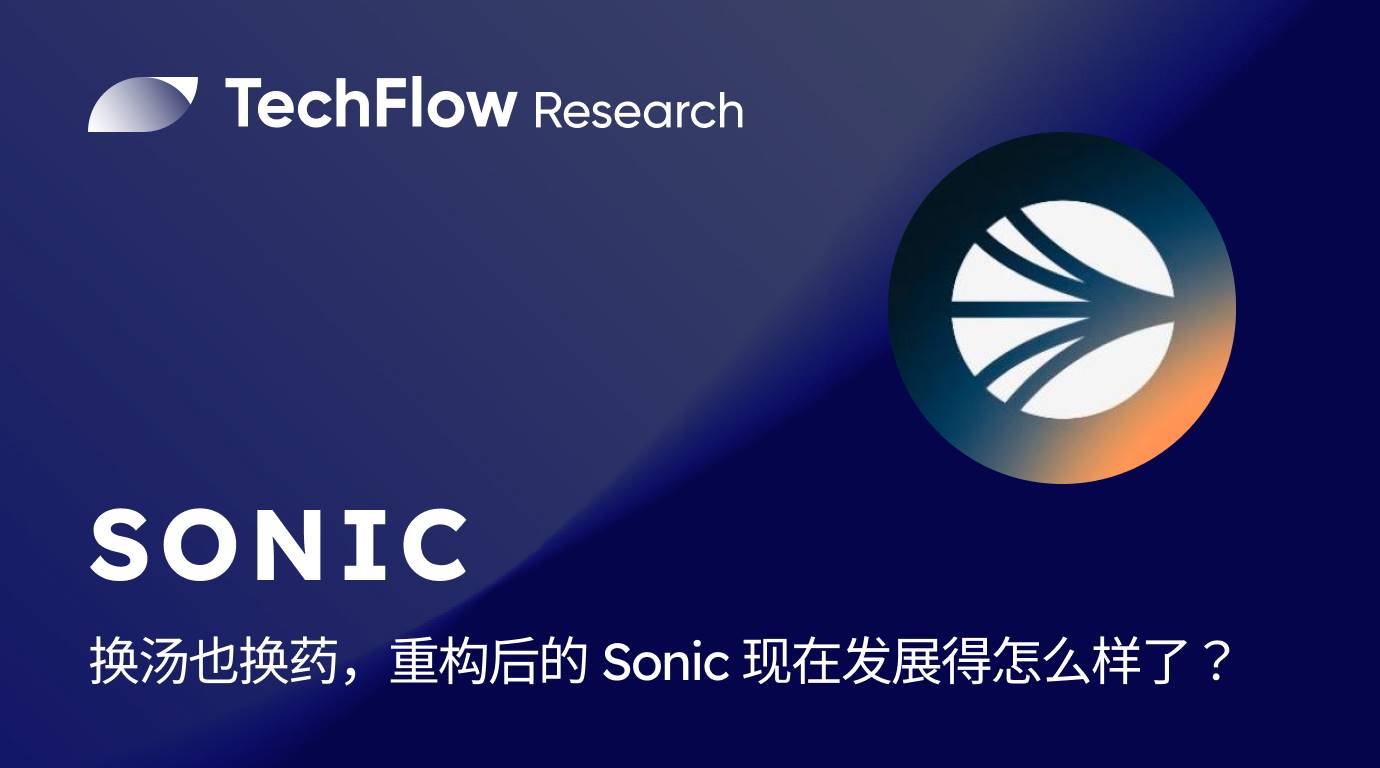
Sonic: The Soul Figure's Marketing Boost and Hardcore Strength
When talking about Sonic, most people's first reaction is: "Isn't this just Andre Cronje rebranding Fantom?" For users standing outside the Sonic ecosystem, it seems that Sonic merely replicates the successful experience of the Fantom ecosystem, but a closer look reveals that Sonic's upgrade is not just a name change.
The Soul Figure
From Fantom to Sonic, AC's presence has always been strong. However, while Fantom performed excellently, there was still room for improvement in performance, and AC's role was more supportive than fully dominant. In the Sonic era, AC is no longer just an advisor but the leader of Sonic, directly steering the ecosystem's development direction. Under AC's leadership, Sonic has built a technological system centered around SonicVM, SonicDB, and SonicCS 2.0, while also integrating Sonic Gateway's native cross-chain solution to provide users with a secure and convenient asset migration channel. This not only continues the technical genes of Fantom but also allows Sonic to establish a foothold in Layer 1 competition from the very beginning.
If Andre Cronje brought solid OG faith and technical support to Sonic, then Daniele Sestagalli has activated this faith and hard power into the ecosystem's vitality. During the Fantom era, Daniele Sestagalli worked closely with AC on technical projects, but in Sonic, he chose to focus primarily on ecosystem marketing. He has shown considerable attention to the Chinese crypto community: not only did he use a marketing strategy involving beautiful KOLs collectively posting selfies with the same copy to create a buzz around their DeFi project ANON (@HeyAnonai), but he also registered his own Chinese account @bigdzhao to engage closely with the Chinese community.
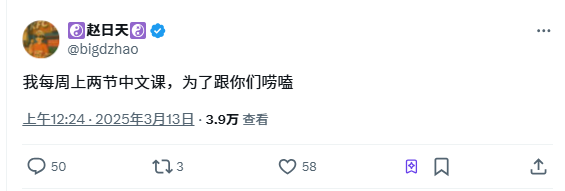
Daniele's image of being in touch with the community has garnered goodwill, allowing users to "understand" Sonic from a unique perspective.
Sonic's Technical Underpinnings
In the current context where EVM public chains generally face performance bottlenecks and Layer 2 solutions are emerging endlessly, Sonic's chosen path of technological evolution clearly has unique insights: achieving performance breakthroughs through underlying architecture reconstruction while maintaining complete EVM compatibility.
Tests have shown that Sonic has achieved transaction speeds exceeding 10,000 TPS. In comparison, Ethereum's TPS is only 30, and Fantom's is 2000, while Sonic's actual performance and theoretical potential have significantly outpaced them. The strong performance release supports high throughput scenarios within the Sonic ecosystem.
Technological innovation is the underlying support for Sonic's excellent performance, and delving into Sonic's technological innovations inevitably leads to SonicVM, SonicDB, Sonic Gateway, and SonicCS 2.0.

- SonicVM: Compatible and Fast
If traditional EVM is an old family car, then SonicVM is a fully modified supercar. SonicVM ensures compatibility with Ethereum's old code (100% EVM compatible, supporting Solidity and Vyper) while significantly enhancing performance. The core selling points of SonicVM mentioned on the Sonic Labs official website are "lightning-fast execution" and "reduced application crashes," which are particularly crucial for Sonic's high throughput demands.
To understand the technical details of SonicVM, we need to start from the underlying logic:
EVM Compatibility and Developer Friendliness: SonicVM is 100% EVM compatible, meaning developers can write code using familiar Solidity and Vyper languages without needing to refactor existing Ethereum applications, supporting the same bytecode execution as Ethereum, ensuring a smooth transition for the ecosystem.
Just-In-Time Compilation (JIT) and Super Instructions: Traditional EVM operates in an interpreted execution mode, translating code line by line, which is inefficient. SonicVM introduces Just-In-Time Compilation, compiling bytecode directly into machine code at runtime, reducing intermediate steps and enhancing execution speed. Additionally, it introduces "super instructions," which combine common sequences of operations into a single instruction, further reducing latency and resource consumption, akin to adding an "accelerator" to the code, allowing smart contracts to run faster, especially in high-frequency trading scenarios.
Thanks to these optimizations, SonicVM can support over 10,000 TPS, compressing confirmation times to sub-second levels, far exceeding the performance bottlenecks of traditional EVM chains.
- SonicDB: Flat Storage, Cost Reduction and Efficiency Increase
SonicDB is the storage layer of the Sonic blockchain, with its core innovation being a change in the traditional data storage method of blockchains.
Traditional blockchains commonly use tree structures like Merkle trees to store data, which, while convenient for verifying data integrity, generate a lot of redundant data. SonicDB adopts a flat storage design, directly organizing related data together, reducing the depth of data storage hierarchy.
When DeFi protocols need to quickly query user balances or transaction histories, SonicDB can directly locate the target data without needing to traverse multiple levels like traditional blockchains. Simply put, SonicDB is like a specially designed super filing cabinet. The traditional way of storing data in blockchains is akin to putting files in a filing cabinet with many layers of drawers, where finding a file requires opening each drawer layer by layer. In contrast, SonicDB uses a more intuitive approach, as if all files are placed in the same layer of drawers, each clearly labeled for easy access when needed.
Moreover, by reducing the storage of redundant data, the hardware costs for node operators are also lowered. According to Sonic's official technical documentation, tests show that when processing the same amount of transaction data, SonicDB's storage space usage is only 60% of that of traditional solutions, while data retrieval speed has improved by 40%.
- Sonic Gateway: The Safest Cross-Chain Bridge
In the cross-chain aspect, Sonic Labs' native cross-chain bridge, Sonic Gateway, provides a sufficiently secure solution. Sonic Gateway employs an innovative heartbeat mechanism, conducting batch transfers of assets from Ethereum to Sonic every 10 minutes, with the reverse occurring every hour.
Additionally, its built-in 14-day fault protection mechanism ensures the absolute safety of user assets—if the gateway fails for 14 consecutive days, users can retrieve their bridged assets on Ethereum. This mechanism cannot be modified by any party once deployed. For users seeking efficiency, Sonic Gateway also offers a "Fast Lane" feature, allowing for instant heartbeats by paying an additional fee of 0.0065 ETH, reducing cross-chain bridging time to just a few minutes.
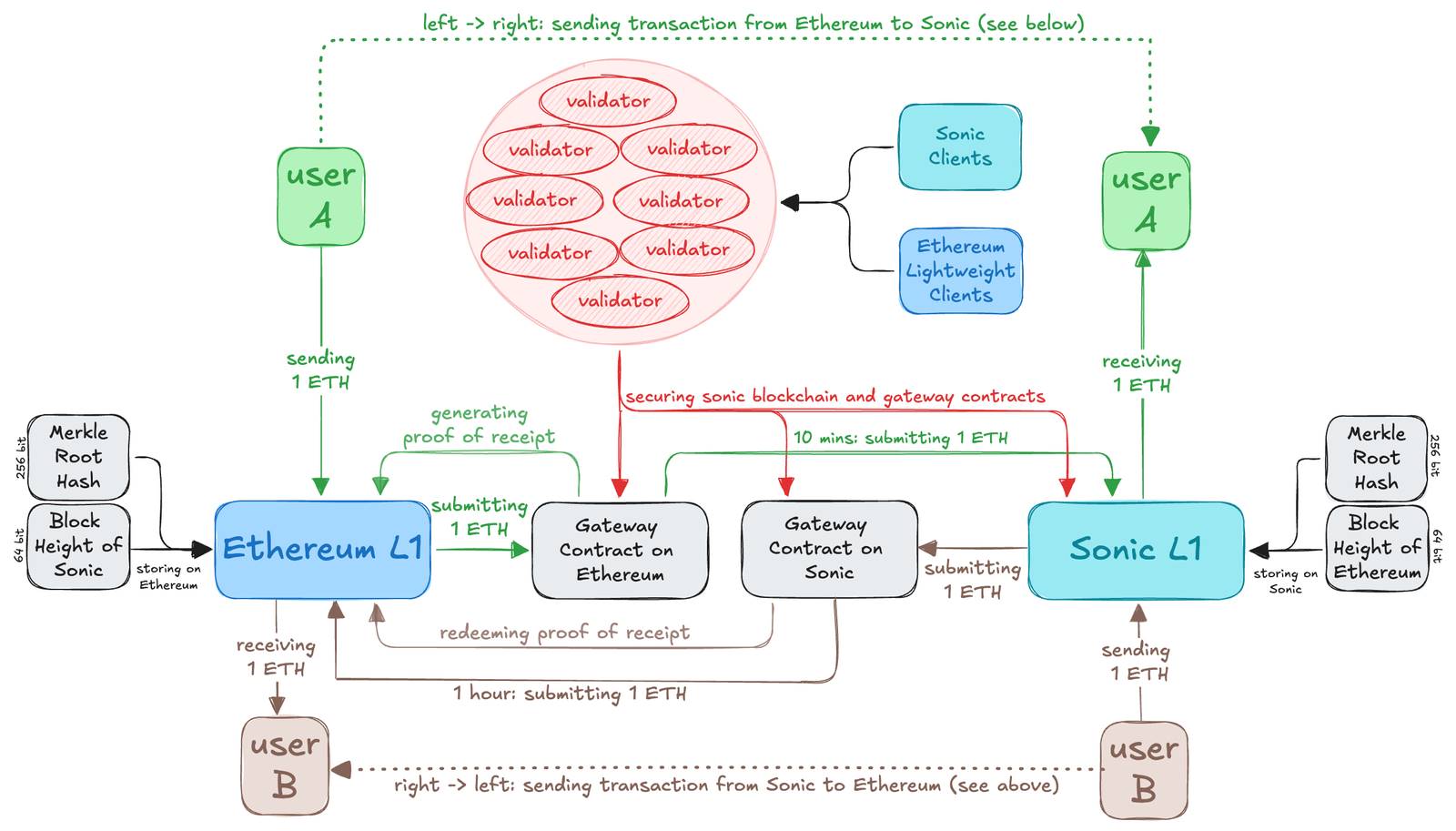
Image Source: Sonic Official Technical Documentation
- SonicCS 2.0: A Consensus Protocol for Multithreaded Work
SonicCS 2.0 is Sonic's latest consensus protocol, utilizing an asynchronous Byzantine Fault Tolerance (ABFT) mechanism based on a Directed Acyclic Graph (DAG). This is a consensus protocol specially optimized for high concurrency scenarios. Unlike traditional methods like Bitcoin or Ethereum, which package transactions into one block after another, SonicCS 2.0 allows multiple validators to process different groups of transactions simultaneously.
Specifically, when multiple transactions arrive at the network simultaneously, different validators can process these transactions in parallel without waiting for the previous block to be confirmed. The processed transactions form a mesh structure, with each new transaction pointing to multiple previous transactions, naturally creating a Directed Acyclic Graph (DAG). This design allows the network to maintain stable operation even when some nodes experience delays or failures. To further enhance efficiency, SonicCS 2.0 innovatively introduces an overlapping election mechanism. The election process for validators begins in advance, partially overlapping with the current consensus cycle, which reduces the waiting time during validator switching. Coupled with an optimized voting mechanism, the entire network can achieve sub-second transaction confirmation speeds while maintaining high security.
For example, suppose there are 100 transactions to be processed simultaneously. Previously, these transactions would have to queue up and be confirmed one by one. However, after the introduction of SonicCS 2.0, multiple validators can work simultaneously, much like several cashiers checking out customers at the same time, significantly increasing processing speed. To ensure this system runs more smoothly, SonicCS 2.0 has also implemented a clever design: while the current validators are still working, the selection of the next batch of validators begins in advance.
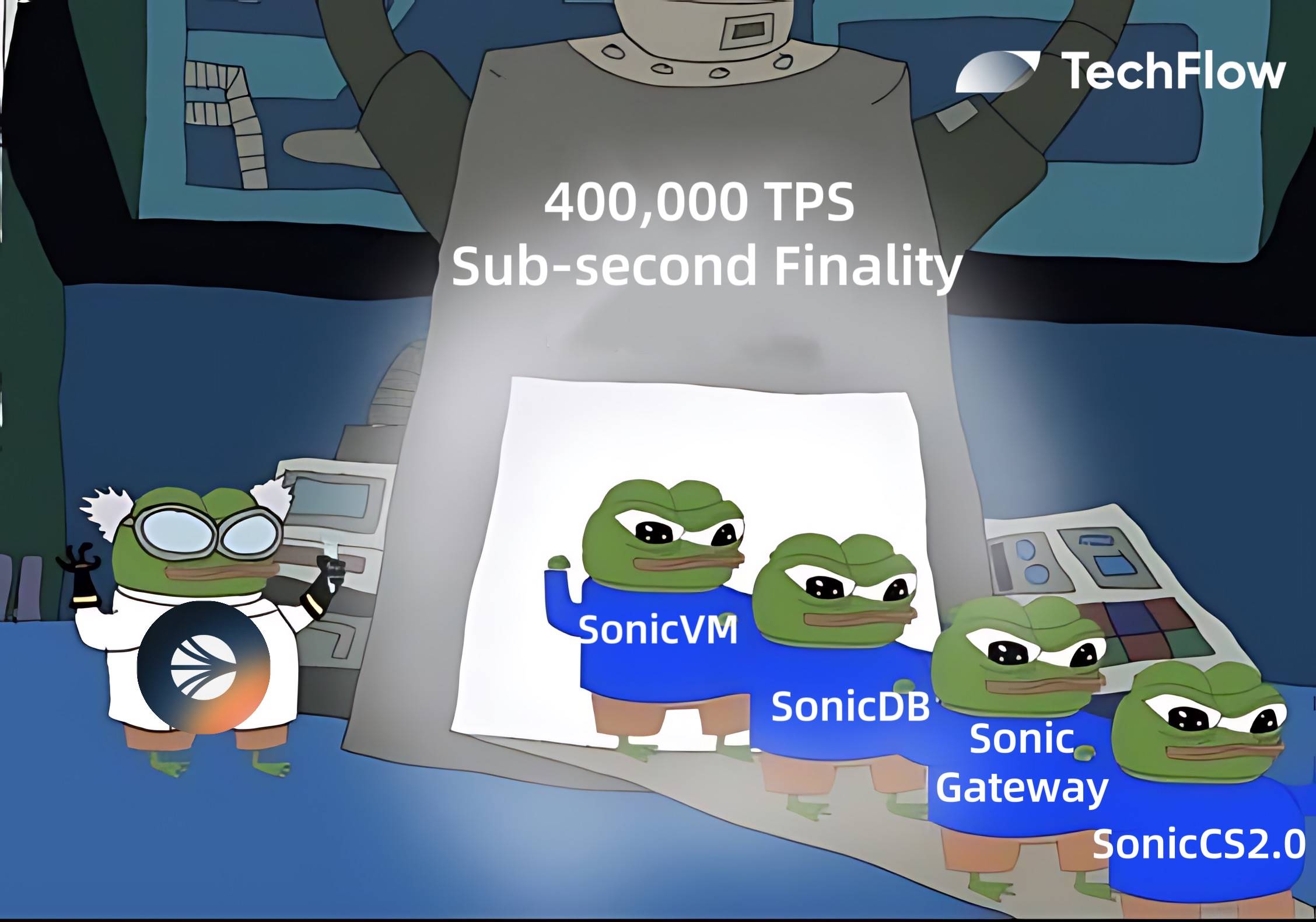
Ecosystem Rewards Most Concerned by Users
In addition to attracting attention through creative social media marketing and hardcore technology, what initially piqued the interest of users and developers in Sonic was its sincere "reward mechanism."
- FeeM Model: Ecosystem Fees Reinvested to Developers
The FeeM (Fee Monetization) model is inspired by the revenue-sharing model of Web2, similar to how YouTube allows content creators to profit from traffic. On Sonic, developers attract users and transaction volume by deploying applications. If users trade on applications participating in FeeM, up to 90% of the transaction fee revenue is directly allocated to developers, while the remaining amount is distributed as tips to validators; if users trade on applications not participating in FeeM, 50% of the transaction fee is directly burned, and the remaining amount is distributed as tips to the ecosystem treasury and validators.

Image: FeeM Revenue Sharing Rules, Data Source: Sonic Official Technical Documentation
This model is fundamentally different from the traditional blockchain "commission" logic, as it directly links network revenue to developers' efforts, incentivizing them to create high-traffic quality applications. With returns, developers are naturally willing to invest more effort into optimizing projects, enhancing user experience, and consequently increasing network activity. Through this approach, Sonic has built a simple yet effective pathway for ecological closed-loop growth.
- Airdrop Points Rewards: Passive Points, Activity Points, Gems
If the FeeM model represents Sonic's sincerity towards developers, then the points reward mechanism is a direct return to users and the community. Sonic has designed a multi-tiered reward system—Passive Points, Activity Points, and App Points (Gems)—with a total of approximately 200 million S tokens to be distributed through airdrops across multiple seasons.
Passive Points: Users only need to hold whitelist assets designated by activities in their Web3 wallets (such as Rabby or MetaMask) to enjoy point earnings. However, assets from centralized exchanges (such as WETH, scUSD) do not count.
Activity Points: By using whitelist assets to provide liquidity or participate in activities within Sonic ecosystem applications, users can earn rewards that are twice as high as passive points.
Gems: Sonic Labs issues Gems points to projects based on their performance in the ecosystem (such as transaction volume or user numbers), which can be exchanged for S tokens. Applications that receive Gems can allocate points to their own users.
To qualify for the S token airdrop, users must hold or use the whitelist assets listed in the table below and earn different point multipliers based on the assets.

Image: Whitelist Assets, Data Source: Sonic Official Technical Documentation
WETH, scUSD, scETH, scBTC, aUSDC, bUSDC.e-20, LBTC, SolvBTC, and SolvBTC.BBN only earn activity points and do not earn passive points. Some whitelist assets will receive multiplier bonuses during the first three months after Sonic's launch to encourage their use and attract more liquidity to Sonic. The official may choose to extend or reduce these enhancements afterward.
Whitelist assets and their multipliers may change. S tokens staked through MySonic do not qualify for point earnings. Users wishing to stake can switch to the liquid staking token stS provided by Beets.
The first season of the airdrop activity ends in June 2025, and progress can be checked at any time through the official dashboard, incentivizing developers to continue contributing quality projects.
For official details, see:
https://docs.soniclabs.com/funding/sonic-airdrop/sonic-points
With marketing skills and financial incentives, along with sufficient technical strength, how should users participate in the opportunity-filled Sonic ecosystem? We have summarized some current potential entry opportunities in the Sonic ecosystem.
Sonic Ecosystem Overview: DeFi is Great, but Not Just DeFi
Sonic's DeFi projects continue the excellent genes of Fantom, and recent micro-innovations have frequently won market favor. Naturally, when people first mention the Sonic ecosystem, the diverse DeFi gameplay often comes to mind. However, while DeFi continues to shine, Sonic's ecological landscape has long since expanded beyond that. AI, GameFi, NFTs, and Meme sectors are also thriving on Sonic, showcasing diverse potential (refer to the ecological application display board: Sonic Labs Apps).
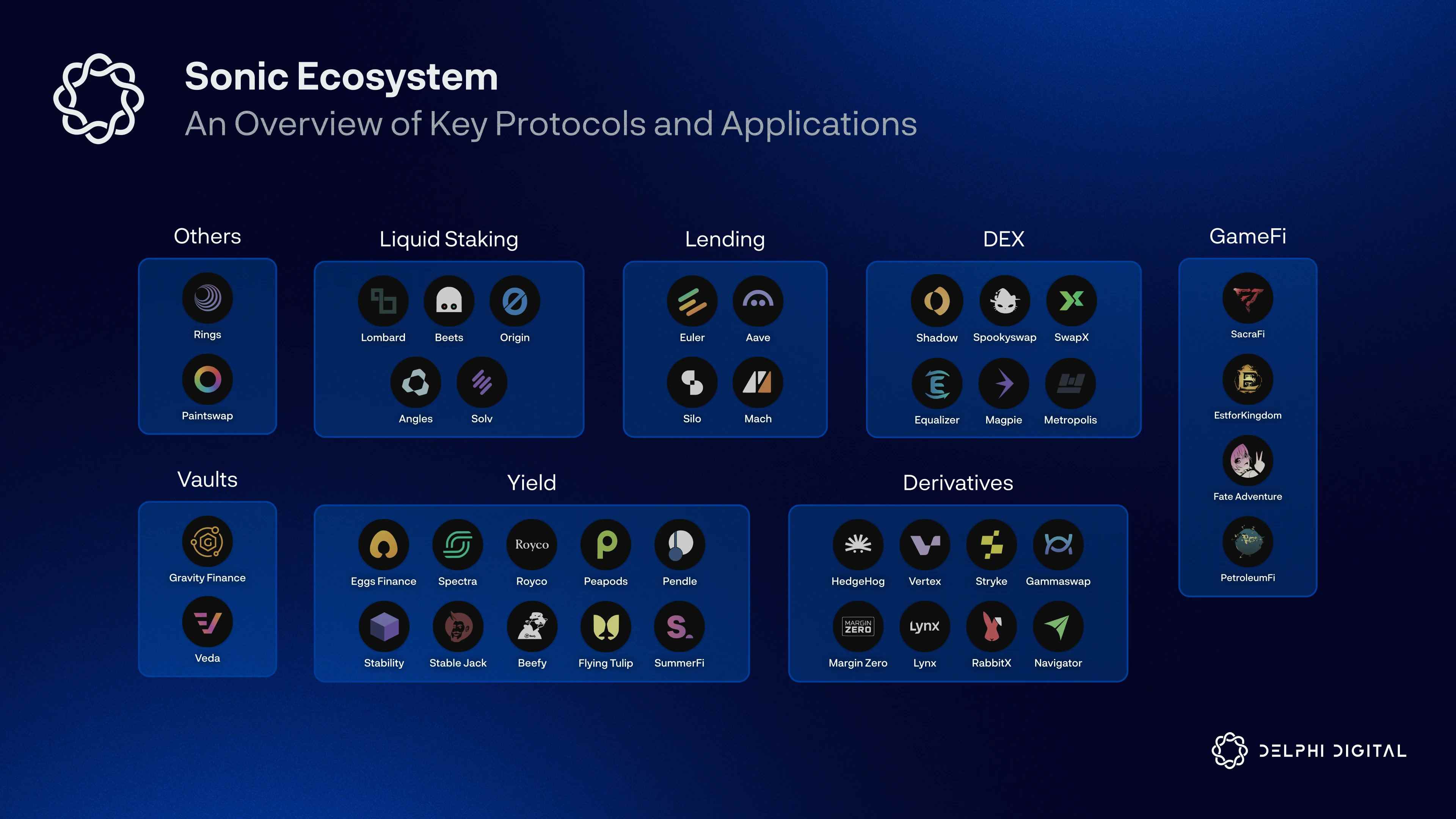
Image: Sonic Ecosystem, Image Source: @Delphi_Digital
DeFi Sector Steadily Gaining Momentum
Shadow (@ShadowOnSonic)
Recently, Sonic's DeFi popularity has been closely tied to the token $SHADOW of Shadow. Shadow is a DEX in the Sonic ecosystem based on the x(3,3) model, with an innovative highlight of transforming the traditional lock-up earning model ve(3,3) into a mutual aid model of "early withdrawal penalties, sharing the remaining profits."
Users can deposit $SHADOW to receive staking certificates $xSHADOW to earn income from various protocols. They can also exit staking at any time, but a certain percentage (varying based on holding time) of tokens will be deducted as an early withdrawal penalty, with the deducted tokens distributed to users who maintain their staking.
Currently, Shadow's daily trading volume remains stable at over $30 million, with cumulative trading fees exceeding $10 million.
Beets.fi (@beets_fi)
Beets.fi (shortened to Beets) is the LST center in the Sonic ecosystem, developed and upgraded by the Beethoven X team. Transitioning alongside Fantom to Sonic, Beets has transformed from a DEX to a core staking and liquidity infrastructure project for Sonic, becoming a pillar project in the Sonic ecosystem, suitable for users seeking stable returns and long-term participation.
Users can stake $S to receive liquid staking certificates $stS, retaining network staking rewards while maintaining asset liquidity. Beets' automatic compounding mechanism allows for continuous accumulation of returns. The platform builds a diverse liquidity pool matrix through $stS, such as the $wOS/$stS pool in collaboration with Origin Protocol, allowing users to capture multiple returns while maintaining exposure to $S.
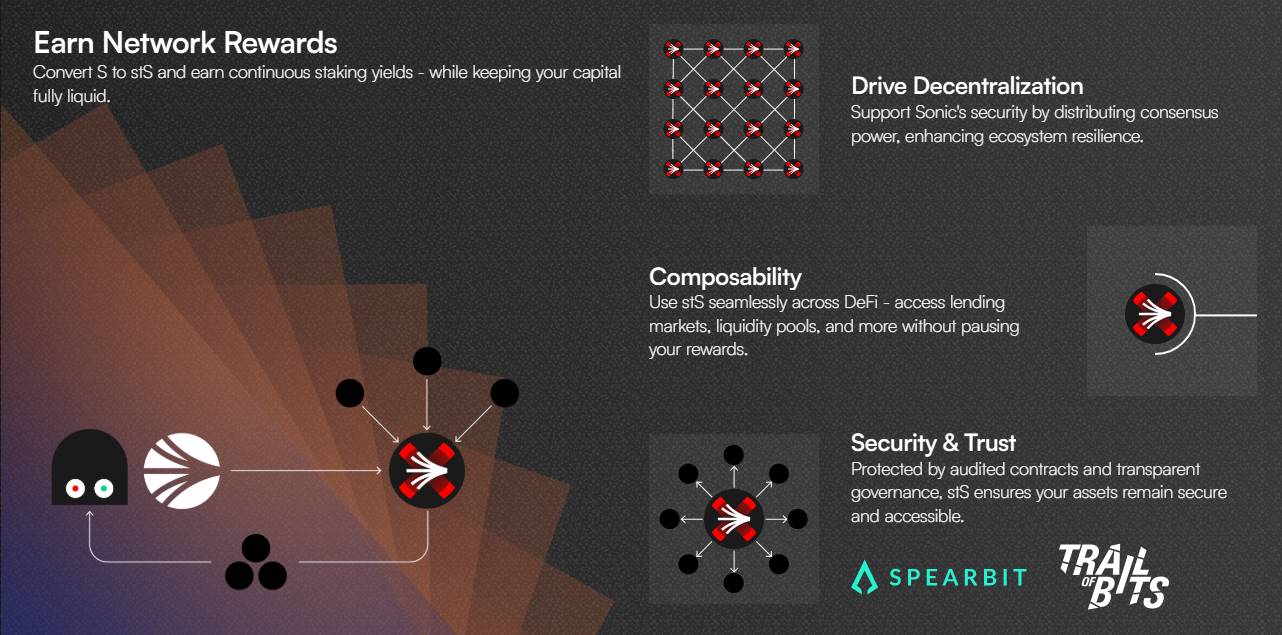
$EGGS (@eggsonsonic)
Eggs Finance (shortened to Eggs) is a leveraged yield protocol on the Sonic ecosystem, combining leveraged yield tools with Sonic's native token $S to create an internal funding circulation system within the ecosystem. The goal is to "allow $S holders to amplify their returns while retaining their positions."
The operational mechanism of Eggs Finance can be summarized as "minting, leveraging, yield cycling":
Users can stake $S in Eggs Finance to mint a derivative token $EGGS, which is pegged to $S but has leveraged properties. The minting cost increases with participation time, meaning early users face lower costs, while later users will have a portion of their $S payments returned to early participants. Subsequently, users can use $EGGS as collateral to borrow more $S and invest it in other pools (such as ShadowOnSonic or Beets) to earn high returns. It has been mentioned on X that the short-term annualized yield of the $EGGS/$S pool once reached as high as 1800%.
Currently, Eggs Finance has been listed on DeFi Llama, with trading primarily conducted on Sonic's DEX.
Silo Finance (@SiloFinance)
Silo Finance is the protocol with the highest TVL on Sonic, with $250 million in TVL accounting for a quarter of the ecosystem's total TVL. Its isolated lending model limits risk diffusion through independent pools, allowing users to deposit $S or $scUSD for high-leverage circular loans to amplify returns. Depositing $scUSD enjoys an 18x SonicPoint bonus, while USDE offers a 12% APR. However, the proportion of circular loans in its TVL may be relatively high, indicating that the actual capital scale might be smaller than displayed, making it very suitable for players seeking high points.
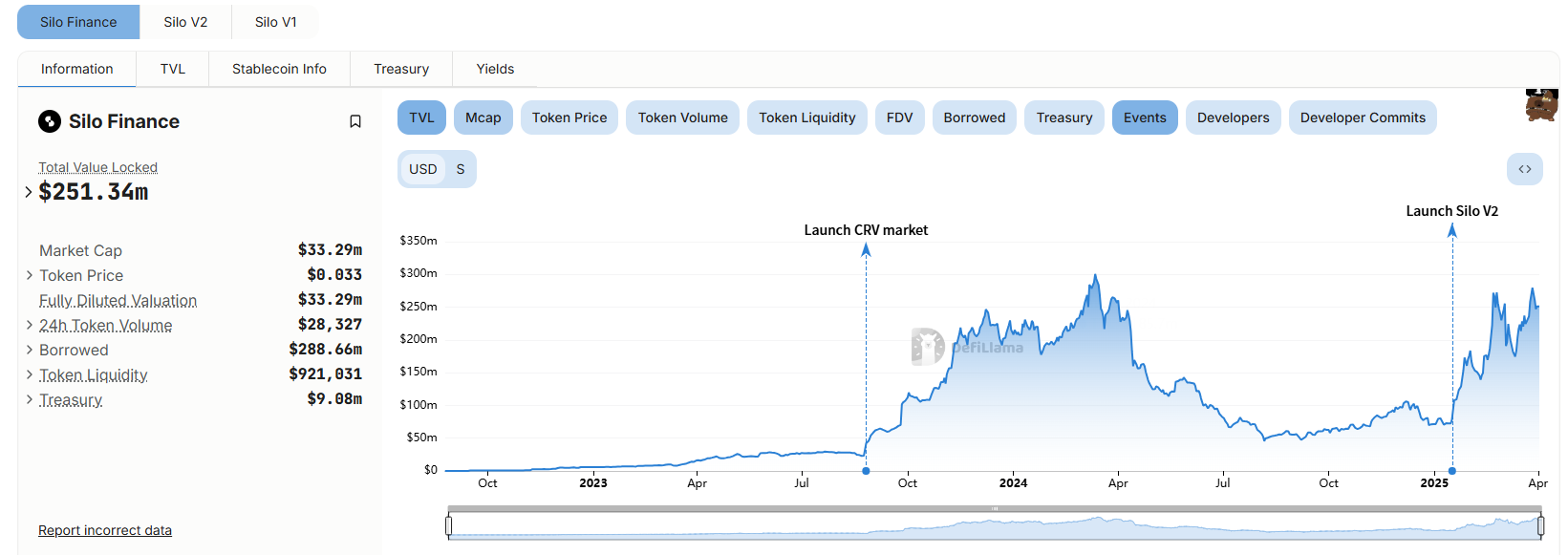
Data Source: DefiLlama
NFT
- Derp (@derpedewdz): NFT & Meme
The Derp series is the leading NFT in the Sonic ecosystem. Most members of the Sonic team and ecosystem OGs, including AC, own Derp NFTs and use them as avatars.
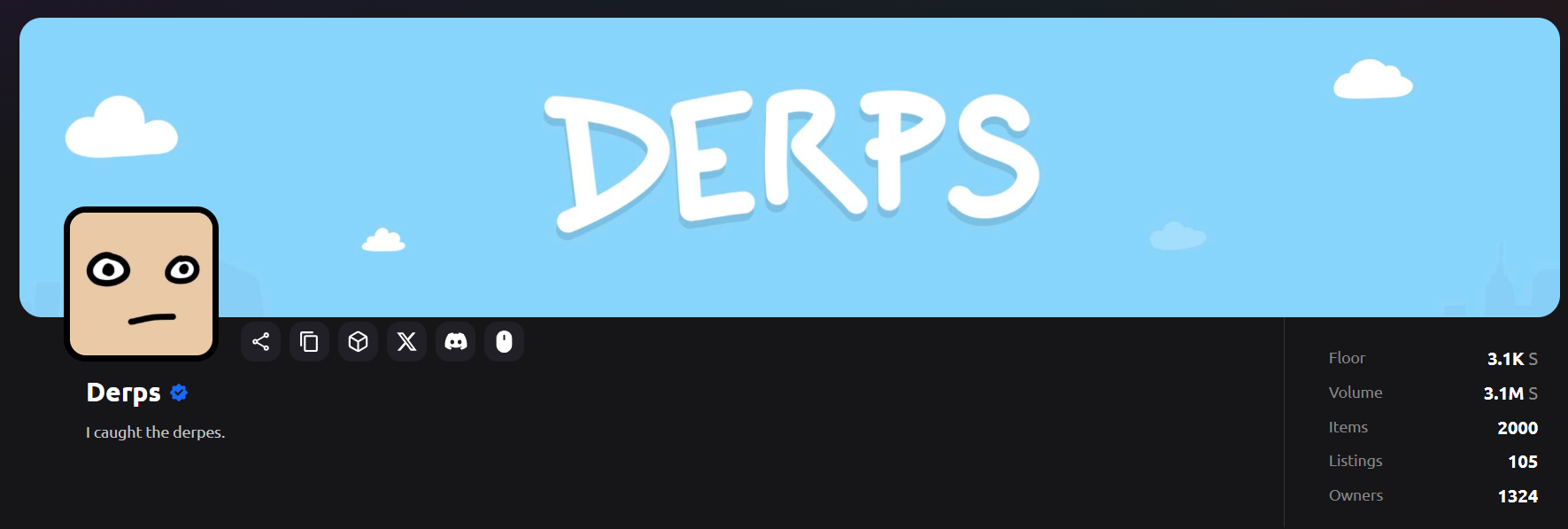
Among them, the first generation of Derp NFTs, the Derpe Dewdz series, was initially sold at auction on Paintswap, with an initial quantity of 100 pieces. The current total is 99, making it the Derp series NFT with the highest floor price weight, currently priced at 8900 $S.
The most popular Derp NFT, the second generation Derps series, has a total of 2000 pieces. As of April 2025, the floor price of derps in the secondary market is 3100 $S, with the highest transaction record at 4850 $S.
The value of the DERP series lies not only in its collectibility but also in the ecological dividends that come after community recognition. Derp holders have received airdrops from projects such as goglz, oil, and shadow.
Additionally, Derp NFT holders can mint 100 Meme tokens $derp every 24 hours and can use $derp to mint Snacks, which can then be fed back to the Derp NFT to burn 45% of the $derp tokens. Feeding a certain quantity will also mint new Derp NFTs from the third generation Berp series, achieving token deflation.
- Paintswap (@paint_swap): NFT & GameFi & AI
Paintswap, which has continued since the Fantom era, is currently the largest NFT trading platform in the Sonic ecosystem, supporting users in minting and trading NFTs. At the same time, Paintswap has issued its own NFT Beardies, and holding Beardies allows users to receive 3% of Paintswap's trading fee revenue.

However, it may be more appropriate to describe Paintswap as a comprehensive application layer rather than just an NFT platform. After all, beyond NFT trading, the Paintswap team has also developed its own game EstforKingdom (@EstforKingdom), a classic medieval adventure-themed idle game where players explore the world through NFT characters, earning tokens and various rewards. Notably, EstforKingdom and the Paintswap platform share the $BRUSH token, greatly reducing the risk of capital and reputation diversion.

Recently, Paintswap launched the GameFAI (AI Game Engine) token economics designed around the ecological token $BRUSH, allowing users with zero experience to create Web3 games using AI and design a series of asset token plans (the actual product has not yet been launched).
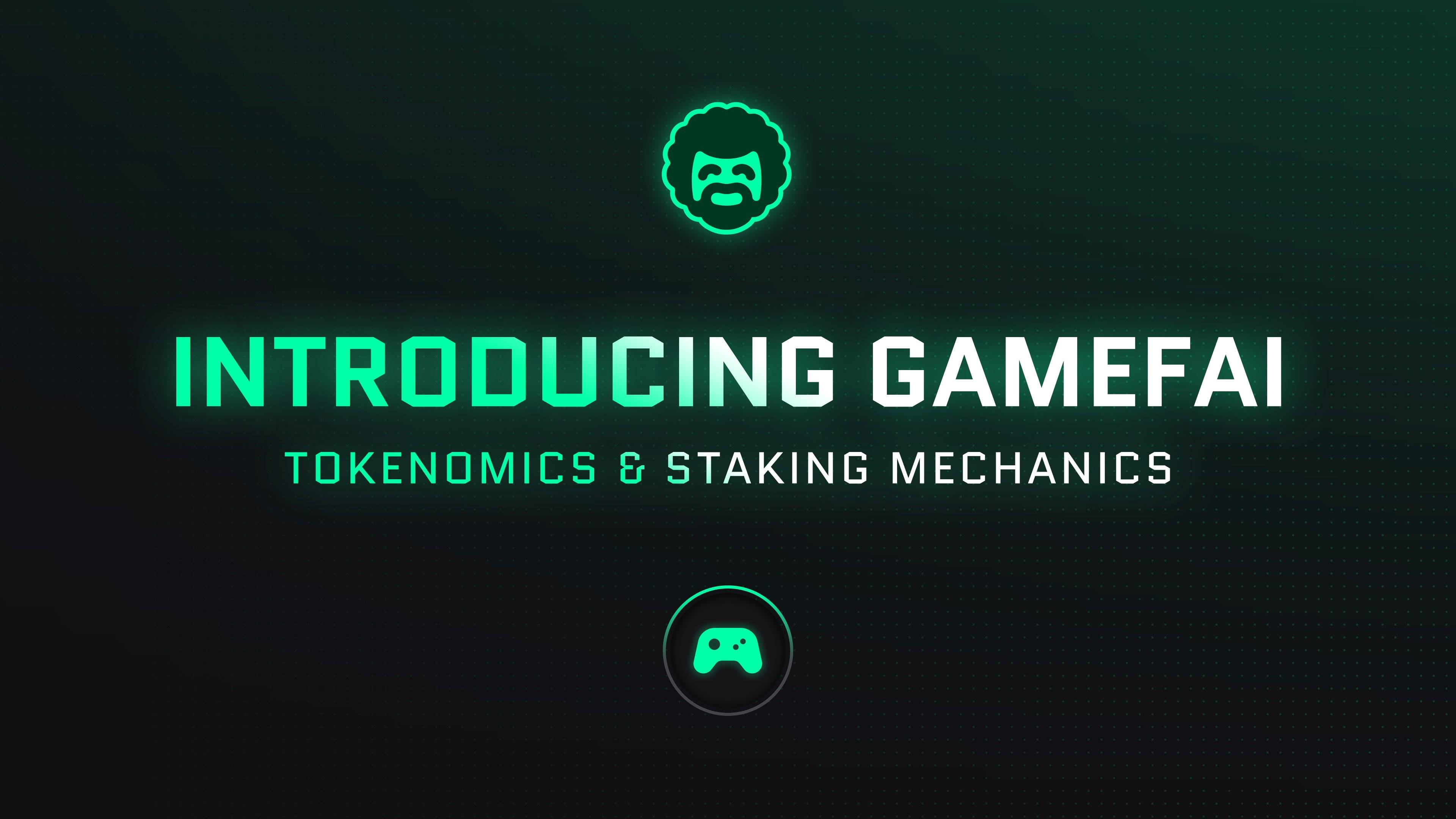
GameFi
- Petroleum Finance (@Petroleum_Defi)
Petroleum Finance is a project that combines NFT and DeFi mechanisms, centered around virtual "oil plot" NFTs (Petroleum Plot) and the native token $OIL. Users can purchase Petroleum Plot NFTs on Paintswap (current floor price 50 $S) and stake them on the platform to mine $cOIL (crude oil). Only after refining (locking) can $cOIL become tradable $OIL (current price $0.79). The longer the locking time, the lower the tax fee required for withdrawal. The rarity of the NFT determines the output efficiency, with higher-grade plots yielding more.

- Fate Adventure (@FateAdventure)
Fate Adventure is a full-chain 2D RPG game in the Sonic ecosystem.
The game is set in a conflict-filled fantasy world where players act as adventurers, collaborating with trainers to summon, train, and evolve monsters called "Lings" to combat the "Consensus" threat that seeks to reset the world. The core token $FA reached a peak price of $1.75, currently priced at $0.24, with a circulating market cap of approximately $2.4 million. Players earn $FA through PvE battles, quests, or cooperative modes and can stake $FA to obtain equipment NFTs.
All game assets in Fate Adventure (such as Lings and equipment) are NFTs that can be traded on Paintswap. Additionally, account abstraction technology lowers the barrier to blockchain interaction, allowing newcomers to participate without needing to deeply understand private keys.
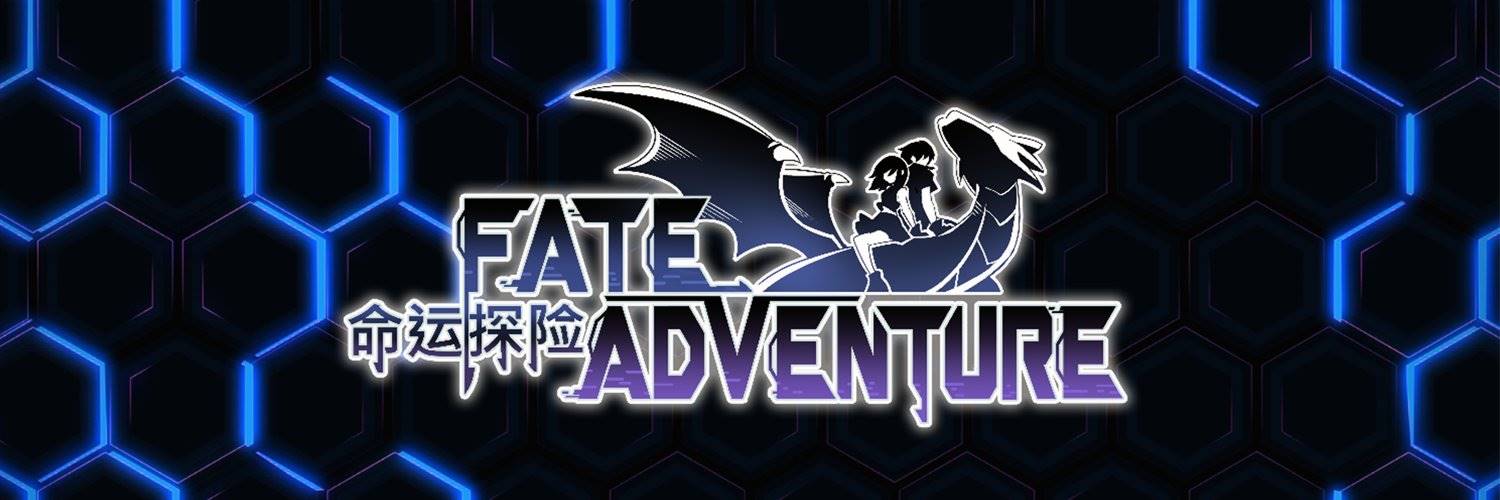
- Abysscards (@abysscards)
Abysscards is a 1v1 collectible card game in the Sonic ecosystem. Starting from March 25, players can mint one unique AI-generated NFT card for free each day, featuring exclusive art and stories. Characters and clans are randomly assigned based on wallet addresses, and the event lasts for 30 days. After the 30-day event, players can use the cards for free battles. However, players will no longer be able to mint cards, and all cards circulated during the Genesis event will become the final version.
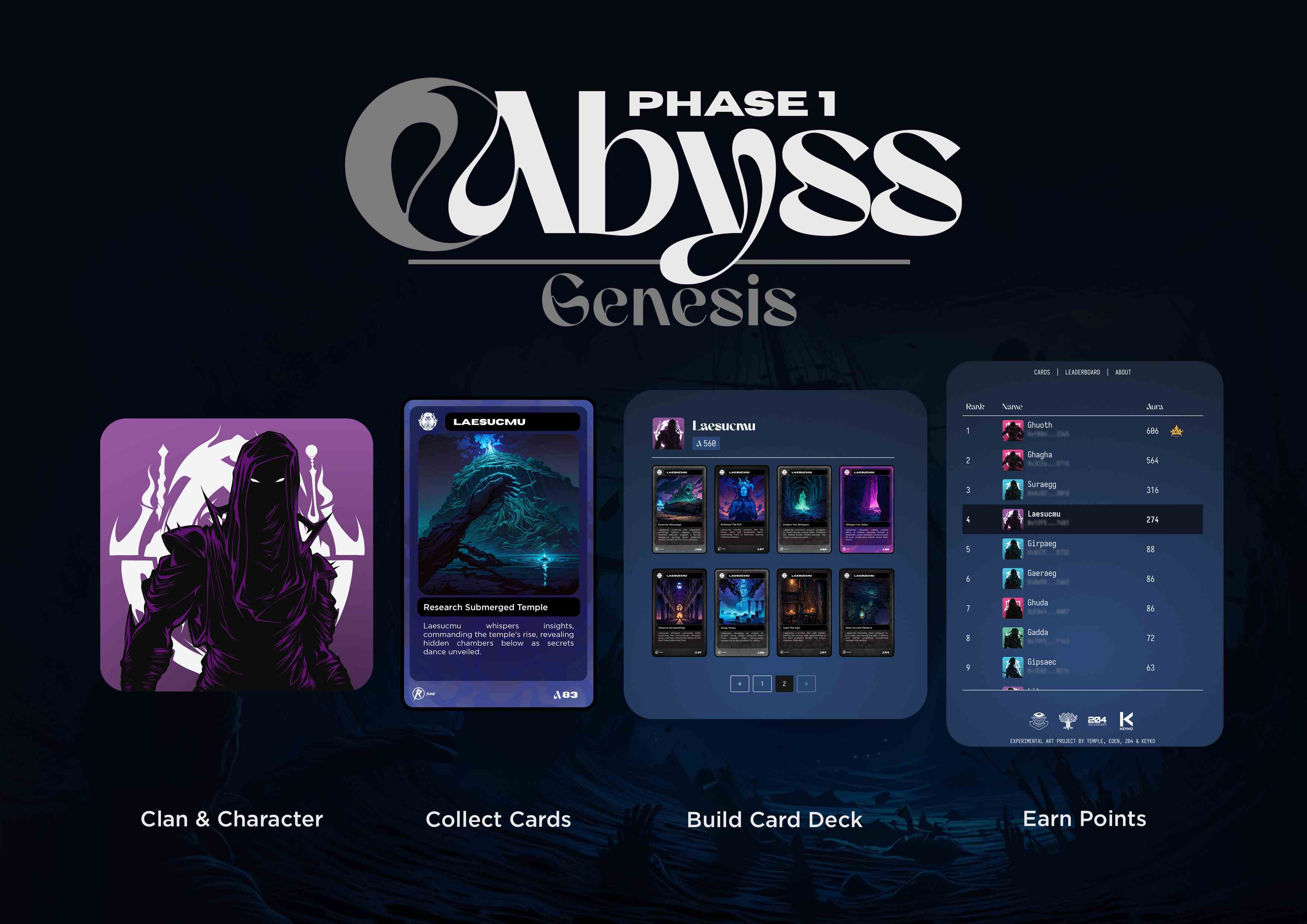
Meme
- GOGLZ (@GOGLZSONIC) vs INDI (@indisonic): Meme & NFT & GameFi
GOGLZ is the leading Meme project on Sonic themed around the concept of "goggles." Recently, GOGLZ collaborated with another Sonic Meme project, Indi, to launch Goglz vs Indi, a wolf-sheep game based on Sonic. The IP images of GOGLZ and Indi are designed as wolf and sheep NFTs, respectively, integrating risk strategies and profit distribution mechanisms.
The core gameplay of Goglz vs Indi is as follows:
Indi NFT (Sheep): Represents the "sheep" character, users can mine the game token $MEOW by staking Indi NFTs. The total daily output is 7500 $MEOW, distributed per second to all staked sheep. When users claim, they receive 80% of the accumulated $MEOW, while the remaining 20% is shared among the wolves. Unstaking requires at least 15000 $MEOW output, and there is a certain probability that $MEOW will be eaten by wolves.
GOGLZ NFT (Wolf): Represents the "wolf" character, which does not directly produce $MEOW but shares 20% of the sheep's output through a "plunder" mechanism when staked. The wolf's profit distribution is linked to "effort points."
Among them, $MEOW is the core token in the game, and users can choose to exchange it for Sonic's native token $S or continue to mint more NFTs to further participate in the game cycle.
Similar to classic wolf-sheep games, sheep holders face potential threats from wolves (such as the risk of NFT or earnings being plundered), while wolves rely on the output from sheep to profit.
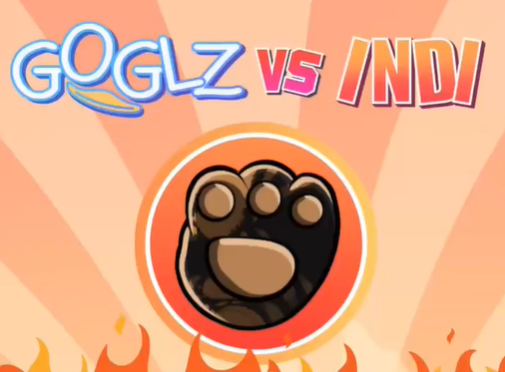
TinHat Cat (@TinHat_Cat)
TinHat Cat features a pink cat wearing a tin foil hat and ranked high in the first Meme competition of the Sonic ecosystem, with trading popularity second only to $GOGLZ.
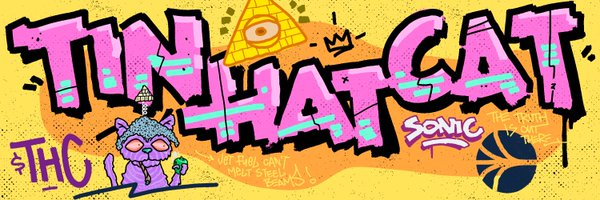
AI
- Hey Anon (@HeyAnonai): DeFi + AI
Hey Anon is a DeFAI protocol developed by Daniele Sestagalli, allowing users to quickly obtain information on price changes, community sentiment, and development dynamics through natural language, while executing complex DeFi operations. For example, users can simply say, "Help me stake 100 $S," or "Convert $scUSD to $stS," and Hey Anon will execute it automatically.
Hey Anon's functionality is deeply integrated with Sonic's main asset operations, supporting assets like $S, $scUSD, and $stS. Meanwhile, Hey Anon's native token $ANON circulates across multiple chains, including Sonic.

- Allora Network (@AlloraNetwork)
Allora Network is a decentralized AI network developed by Allora Labs, built on the Cosmos SDK, aimed at helping on-chain data prediction and optimization. Allora will join the Sonic ecosystem in early 2025.
In the Sonic ecosystem, Allora optimizes DeFi and GameFi applications. It provides market trend predictions for Shadow and Wagmi, adjusts liquidity pool yields; analyzes user behavior for Sonic's point system (Passive and Activity Points) to dynamically optimize reward weights; and offers data support for games like Fate Adventure to balance economic models. Currently, Allora has launched its Dev Mainnet.

- Yoko (@yokodotlive)
Yoko is an AI agent economy platform in the Sonic ecosystem, allowing users to easily create their own AI agents through the Yoko platform and execute a series of on-chain trading operations via these agents.
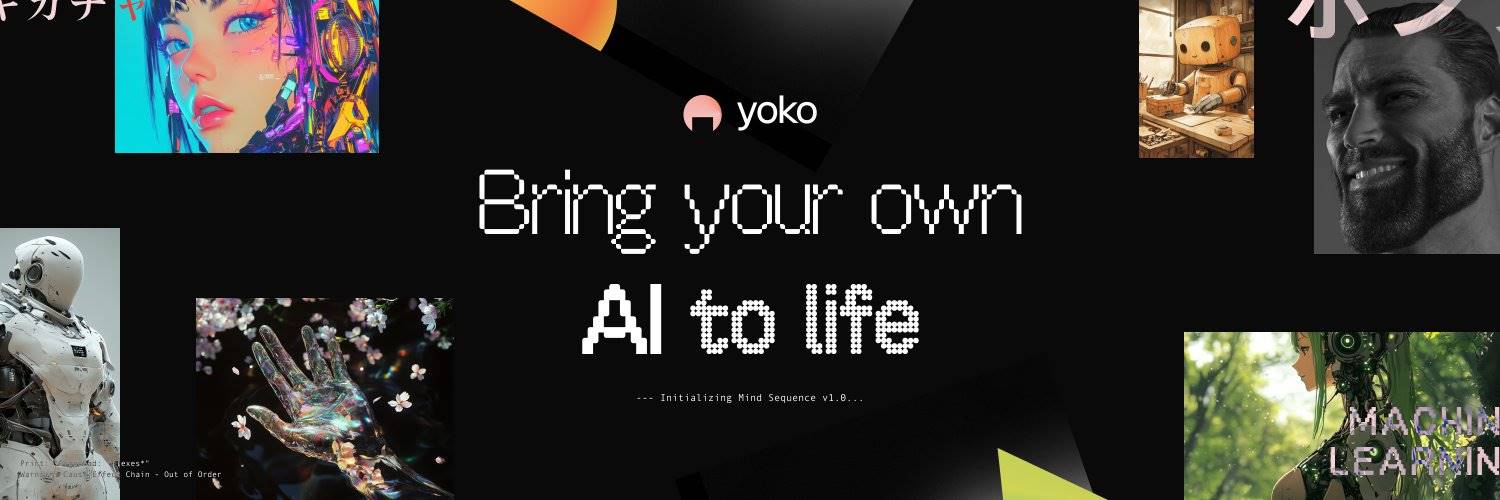
Rebuilding After the Storm
Clearly, under the repeated baptism of bearish market sentiment, the demand for public chains has quietly shifted. While the temptation of short-term profits still exists, more and more users are beginning to realize that projects capable of weathering cycles often possess greater patience and long-termism.
The development trajectory of Sonic precisely confirms this. Unlike other projects that solely pursue short-term explosions, Sonic has chosen a path of "slow and steady wins the race." Since the reconstruction began last December, what we have seen is not a fleeting Meme frenzy, but a gradual evolution from a small number of ecological projects to a thriving ecosystem with continuous DeFi innovations. Achieving a robust growth of $1 billion in TVL within just four months, the market is paying real money for Sonic.
In the current environment where stories of sudden wealth bring ecological traffic, Sonic's development approach may seem somewhat "slow," but its step-by-step strategy is guiding the entire ecosystem towards long-term construction, as Sonic is building an ecosystem that can withstand market tests.
As the market gradually bids farewell to the speculative phase solely supported by narratives, those projects that consistently focus on value creation and adhere to long-termism will inevitably stand out in the cycles. After the reconstruction, Sonic is steadily moving towards the next round.
免责声明:本文章仅代表作者个人观点,不代表本平台的立场和观点。本文章仅供信息分享,不构成对任何人的任何投资建议。用户与作者之间的任何争议,与本平台无关。如网页中刊载的文章或图片涉及侵权,请提供相关的权利证明和身份证明发送邮件到support@aicoin.com,本平台相关工作人员将会进行核查。




